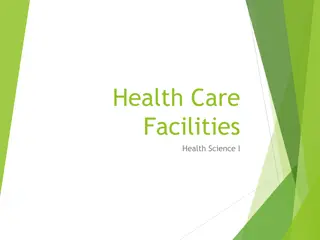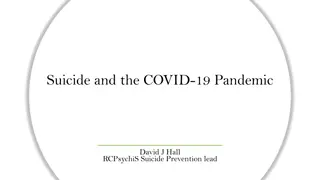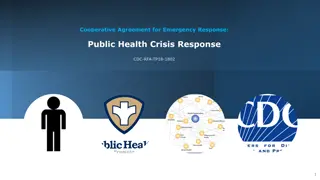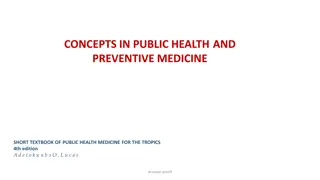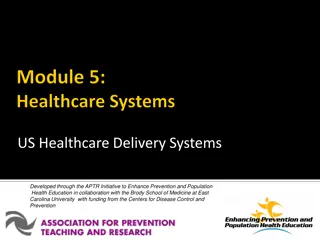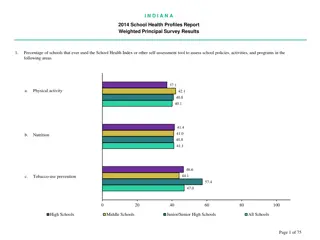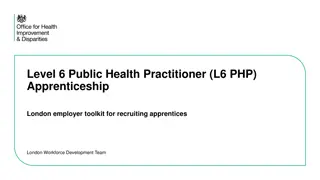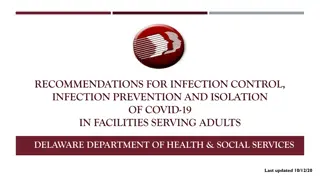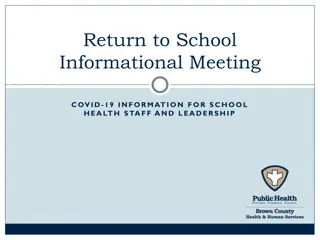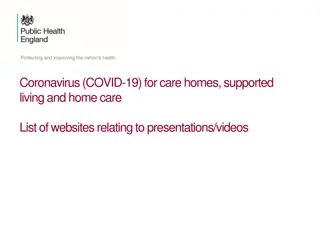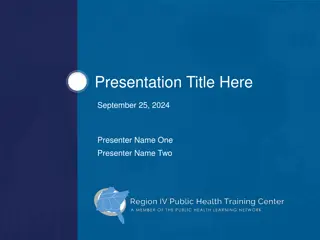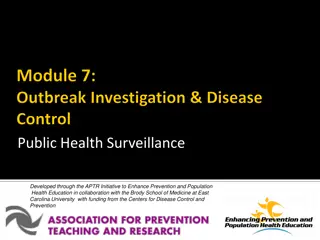Understanding COVID-19: Facilities, Prevention, and Public Health Systems
Learn about COVID-19, its symptoms, prevention measures, and the development of facilities and equipment to tackle the pandemic. Discover how to protect yourself, recognize symptoms, and contribute to public health systems during these challenging times.
Download Presentation

Please find below an Image/Link to download the presentation.
The content on the website is provided AS IS for your information and personal use only. It may not be sold, licensed, or shared on other websites without obtaining consent from the author. Download presentation by click this link. If you encounter any issues during the download, it is possible that the publisher has removed the file from their server.
E N D
Presentation Transcript
OGHENEFEJIRO AGWERE 17/ENG04/003 ELECTRICAL AND ELECTRONICS
DEVLOPMENT OF ENVIRONMENTAL HEALTH ENGINEERING FACILITIES, EQUIPMENTS, SENSORS AND PUBLIC HEALTH SYSTEMS FOR TACKLING COVID-19
CORONAVIRUSES These are large groups of viruses that can causes illness in animals and humans. Some coronaviruses commonly circulates in the united states and usually upper respiratory symptoms such as cough or running nose, although some can cause more serious illness. COVID-19 COVID-19 is a disease that was identified in late 2019 and was declared a pandemic in march 11. COVID-19 is an international, national and North carolina public health emergency.
PUBLIC HEALTH SYSTEM Coronaviruses like COVID-19 are most often spread through the air by coughing or sneezing, though through personal contact (include touching and shaking of hands) or through touching your nose, mouth or eyes before washing your hands. 1. 2. 3. Symptoms of COVID-19 are: Fever Cough shortness of breath Symptoms may appear 2-14 days after exposure We are recommended by the CDC (Centres for disease control and prevention) to stay at home and separate yourself from other people in the home as much as possible if: You are sick with COVID-19 You believe you might have it You think you might have COVID-19 and have mild symptoms 1. 2. 3.
PREVENTION There s currently no vaccine to prevent coronavirus disease (COVID-19). You can protect yourself and help prevent spreading the virus to others if you: 1. Do Wash your hands regularly for 20 seconds, with soap and water or alcohol- based hand rub Cover your nose and mouth with a disposable tissue or flexed elbow when you cough or sneeze Avoid close contact (1 meter or 3 feet) with people who are unwell Stay home and self-isolate from others in the household if you feel unwell 2. Don t Touch your eyes, nose, or mouth if your hands are not clean
FACILITIES AND EQUIPMENTS FOR TACKLING COVID-19 Facilities serve as isolation centres and intensive care units for COVID-19 patients. Here doctors and nurses are provided to help treat and provide the necessary medicine for the patients. These facilities could include Hospitals: Isolation centers:
EQUIPMENTS FACE MASKS: What are the three primary types of face masks? When you hear about face masks for COVID-19 prevention, it s generally three types: homemade cloth face mask surgical mask N95 respirator A. Homemade cloth face masks To prevent the spread of the virus from people without symptoms, the Centers for Disease Control and Prevention (CDC) is now recommending that everyone wears cloth face masks, such as homemade face masks, while in public places where it s difficult to maintain a 6-foot distance from others. This recommendation is in addition to continued social distancing and proper hygiene practices.
Recommendations include Wear cloth face masks in public settings, especially in areas of significant community-based transmission, such as grocery stores and pharmacies. Don t put cloth face masks on children under the age of 2, people who have trouble breathing, people who are unconscious, or people who are unable to remove the mask on their own. Use cloth face masks rather than surgical masks or N95 respirators, as these critical supplies must be reserved for healthcare workers and other medical first responders. Healthcare professionals should exercise extreme caution when using homemade face masks. These masks should preferably be used in combination with a face shield that covers the entire front and sides of the face and extends to the chin or below. NOTE: Wash homemade cloth masks after every use. When removing, be careful not to touch your eyes, nose, and mouth. Wash hands immediately after removing. Benefits of homemade face masks Cloth face masks can be made at home from common materials, so there s an unlimited supply. They may lower the risk of people without symptoms transmitting the virus through speaking, coughing, or sneezing. They re better than not using any mask and offer some protection, especially where social distancing is hard to maintain.
B. Surgical masks Surgical masks are disposable, loose-fitting face masks that cover your nose, mouth, and chin. They re typically used to: protect the wearer from sprays, splashes, and large-particle droplets prevent the spread of potentially infectious respiratory secretions from the wearer to others Surgical masks can vary in design, but the mask itself is often flat and rectangular in shape with pleats or folds. The top of the mask contains a metal strip that can be formed to your nose. Elastic bands or long, straight ties help hold a surgical mask in place while you re wearing it. These can either be looped behind your ears or tied behind your head. C. N95 respirators An N95 respirator is a more tight-fitting face mask. In addition to splashes, sprays, and large droplets, this respirator can also filter out 95 of very small particles. This includes viruses and bacteria. 1. 2.
HAND SANITIZERS: Hand sanitizers were first introduced in 1966 in medical settings such as hospitals and health care facilities. Hand sanitizer is a liquid or gel generally used to decrease infectious agents on the hands. Formulation of alcohol-based types are preferable to hand washing with soap and water. It is generally more effective at killing microorganisms and better tolerated than soap and water. Hand Hygiene is an important response to COVID-19. Washing hands often with soap and water for at least 20 seconds is essential, especially after going to the bathroom; before eating; and after coughing, sneezing, or blowing one s nose. If soap and water are not readily available, the Centers for Disease Control and Prevention (CDC) recommends consumers use an alcohol-based hand sanitizer that contains at least 60 percent alcohol (also referred to as ethanol or ethyl alcohol).
GLOVES: COVID-19 is spread mainly in the air The virus that causes COVID-19 is mainly spread from person to person through respiratory droplets when an infected person coughs or sneezes. And that happens when people are within 6 feet of one another. The other way you can get the virus is from contaminated surfaces. So whenever you touch a surface with the virus on it and then touch your mouth, nose or eyes, you ve possibly exposed yourself to the virus. However, the U.S. Centers for Disease Control says this doesn t appear to be the main way that the virus is spread. Gloves = false sense of security? Thoroughly washing your hands for at least 20 seconds remains the best defense against COVID-19. But when you go to the grocery or other public places, you may not have access to soap and water, hand sanitizer or wipes to clean grocery carts. That s why some people are wearing gloves. But wearing gloves can give you a false sense of security. Because the virus adheres well to latex and other types of gloves, if you touch your face at any point, you ve still potentially exposed yourself to the virus.
Proper glove use is key Plus, many people don t know the proper way to take off gloves and can contaminate their hands when taking off gloves. For example, after you take off your left glove with your right gloved hand, your left hand is at that point virus free. But if you take off your right glove by touching the outside of it, you ve potentially contaminated your left hand. You need to reach inside your right glove and peel it inside out without touching the outside, which can take some skill


